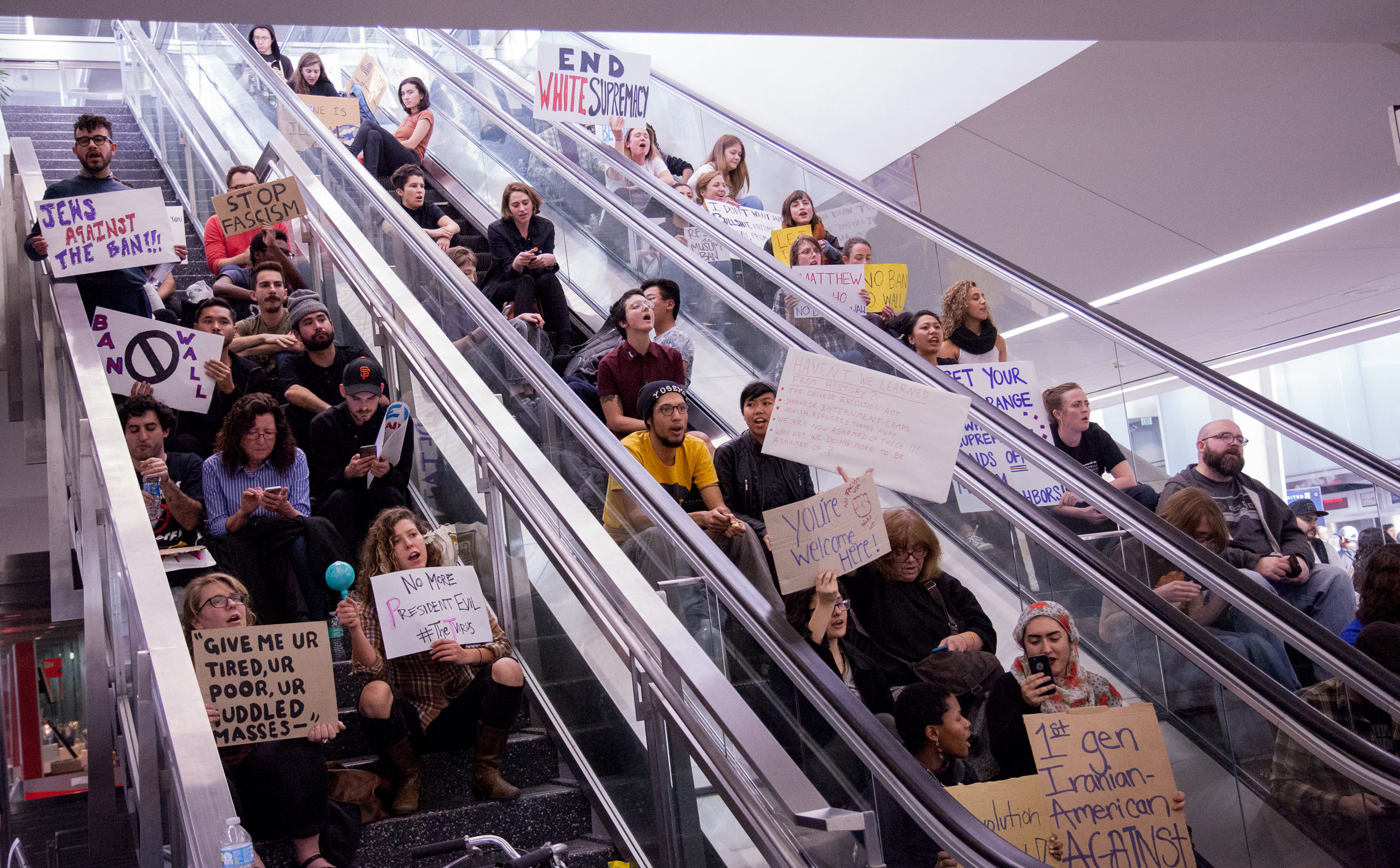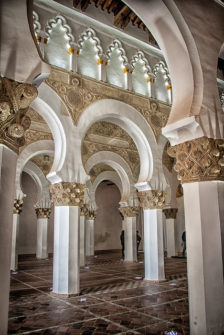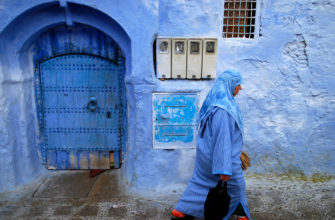
“The political and intellectual history of modernity,” writes historian Robert Orsi, “is also always a religious history.” However, as significant and diverse recent scholarship is now bringing to light, narratives around the political, intellectual, and religious history of modernity often serve not only to illuminate the past, but also to obscure it through the authorization of specific forms of experience and knowledge.
This symposium, entitled “Decolonizing Narratives, Denaturalizing Modernity,” aims to highlight recent scholarship that complicates received notions around the history of modernity. While focusing on distinct temporal, geographical, and religious contexts, in their shared attempts to uncover histories hidden by the dominant discourses of modernity, the authors featured in this symposium uniformly challenge the naturalization of modernity’s emergence and indicate that that the history of modernity has always been (and remains) fundamentally contested.
The photo of two children of different religious backgrounds protesting side by side inside the Chicago O’Hare airport on a cold January 2017 morning was enthusiastically ‘liked,’ ‘posted,’ and ‘re-tweeted’ thousands of times on social media. The context of this intercultural encounter was not random. The new political juncture had created networks of racialized populations facing immense pressure. The travel ban against Muslims, the ICE raids targeting Latinxs, and the attacks against Asians in public spaces had become normalized as part of a new tragic reality. Even the Jewish Community Centers, institutions largely incorporated into liberal white society, suffered a string of bomb threats. A number of these communities launched struggles that paralleled those of pre-election movements against anti-Black racism (Black Lives Matter) and Native invisibilization (Standing Rock).
In this volatile context, two parents, one Jewish and one Muslim, joined the protest against the travel ban on January 30th at Chicago’s largest airport with their kids, Maryam and Adin. During this protest, the kids, who were riding on their parents’ shoulders, encountered one another and exchanged gazes full of deep solidarity. The picture of two “immemorial enemies,” one wearing a hijab and the other a yarmulke, engaging in a true act of comradeship quickly captivated the imagination of the Facebook/Twitter/Instagram market. A young man from California wrote “Only in America,” while a middle-aged woman from New York pleaded “we should learn from these innocent children.” The picture represented what a large part of the Western liberal population needed to see: that even in the most challenging moments, the U.S. was still symbolized by pure and innocent individuals able to start a life beyond ancestral enmity.
It is not surprising that those practicing a liberal reading rejoiced at the image. They saw in it the true spirit of the American system: the altruistic and progressive incorporation of difference into a national community able to self-correct its past injustices. Furthermore, the “land of the free,” the ultimate consummation of Western ideals, is the ideal space to leave behind ancient hatreds. There may be no better example of this than a re-encounter between Muslim-Arab and Jewish populations that have been (allegedly) murdering each other since Biblical times. This hatred, however, is far from eternal. It is, on the contrary, a very recent fabrication of the same altruistic West that now intends to mediate among the parties, portraying itself as the only neutral ground for reconciliation. The question is, then, whether the perpetrator and beneficiary is the best candidate to solve the problem it created.

This is where a Jewish decolonial critique of Western modernity, in conversation with other voices, can offer its two cents. A new world came into existence in 1492 with a process that led to European accumulation of capital and a self-appointed epistemological privilege following the conquest, forced conversion, genocides, and/or enslavement of Jews, Muslims, native peoples, and Africans. Veiling the newly acquired resources that enabled the nascent West to launch industrial and political revolutions, this system started dividing into two groups the populations whose resources were being stolen. On the one hand “people with no religion,” largely representing “Native” and “Black” populations, and on the other, “people with the wrong religion,” generally characterizing Jews and Muslims. This division became a core component of coloniality, or the patterns of domination developed during colonial times that transcend time and space and continue until the present day.
From the fifteenth to the nineteenth century both groups suffered increasing racialization. The “people with no religion” were categorized as people with no history, civilization, or development. The system, then, altruistically offered them the evasive possibility of saving themselves by erasing their past and accepting their alleged cultural or biological inferiority. Even in current political discourses, the intention of helping “inner-cities” escape their underdevelopment attests to how coloniality is very much alive. The “people with the wrong religion” were described as “being stuck” or “having a regressive” history, civilization, or development. Since theirs was an alternative, erroneous system, they were portrayed as threats to civilization. The longevity of this narrative in the U.S. was evident in the Communist Jew represented by the Rosenbergs yesterday and in the banned Muslim today.
In the nineteenth century, imperialism elevated some minorities above the general Muslim population to dismember one of the last non-Western powers, the Ottoman Empire. In the Jewish case European powers were aided by Jewish continental communities who were eager to prove they could erase their uncivilized past and earn citizenship in their own European context. Importing the history of Western anti-Semitism to narrate the history of Arab Jews, colonial powers justified their conquest, altruistically pretending to “save” not only Christian but also Jewish populations from the “regressive” forces of Islam (and Jewish Arabs from their own “underdevelopment”). While this strategy was premodern, coloniality added a fundamental twist. If before modernity genocides were perpetrated to “altruistically” save Christians (the Crusades), in modernity this narrative was mobilized to rescue others from alleged barbarism: Natives from human sacrifices, Africans from cannibalism, and now Jews. Western altruism seems to have recurring ends.

What this narrative obscured is that Jewish history in Muslim-ruled lands was far from identical to the Jewish experience in Christian Europe. This does not mean there were no problems, but Jews were an integral part of the social fabric of Muslim-Arab/Berber societies and this conviviality was present well beyond the sometimes over-romanticized experience of el-Andalus. For over a millennium Jews lived among Muslim populations within a clear protected legal structure (dhimmi and then zimmet). Several Jewish communities have had a continuous presence in the region, refuting the Christian myth of the “wandering” Jewish existence as a punishment for the rejection of Christianity. Under the auspices of the Ottoman rulers, Jews who escaped Christian persecution (starting but not limited to the fall of Granada in 1492) commonly found refuge among Muslims. By the seventeenth century major cities in the Ottoman Empire had Jewish majorities or a distinctive presence.
It is not a coincidence that even with the gradual erasure of Arab Jewish history, Jews at large were still being accused by Western luminaries of having an “Oriental Spirit,” portrayed as a “Palestinian Race” or looking like “Asiatic Refugees.” Edward Said points out the connection between anti-Semitism and Orientalism, and Ella Shohat explains how the same logic was applied to Arab Jews. Despite the efforts to split Jewish and Arab populations, the connection between them endured. In the late nineteenth century it was a Jew (Yaqub Sanua) who coined the slogan “Egypt for Egyptians;” during the Holocaust, Albanian Muslims quintupled their Jewish populations hiding refugees; and on the eve of the postcolonial struggle in Morocco, Sultan Mohammed V called for an anti-colonial “Jewish-Muslim-Berber” alliance. This bond came to be broken only in 1948 (or during the 1956 Suez Canal crisis) with the ultimate naturalization of Jews as Westerners in Israel, the US, and eventually the rest of the world. The “eternal” enmity, then, was a colonial fabrication built on altruistic discourses that are less than 180 years-old (more realistically, 70 years-old).
A Decolonial Jewish re-evaluation of narratives of eternal enmity can shed light upon the perverse altruism of the Western project. While witnessing Neo-Nazis shouting “Jews will not replace us” in Charlottesville, some may feel nostalgic for liberalism. However, we need to evaluate whether the roots of this discourse are not already contained in the colonial manipulation of racialized populations. Liberal altruism may well be the problem and not the solution. The Jewish-Muslim case is one of many that invite us to unveil what has been hidden, contest what has been naturalized, and move beyond modern/colonial liberal narratives.
Further Reading
Ammiel Alcalay, After Jews and Arabs (Minneapolis: University of Minnesota Press, 1993).
Gil Anidjar, The Jew, The Arab: A History of the Enemy (Stanford: Stanford University Press, 2003).
Gil Z. Hochberg, “‘Remembering Semitism’ or ‘On The Prospects of Re-Membering the Semites’” Re-Orient: The Journal of Critical Muslim Studies 1.2 (Spring 2016): 192-223.
Ramon Grosfoguel, “The Structure of Knowledge in Westernized Universities: Epistemic Racism/Sexism in the Four Genodies/Epistemicides of the Long 16th Century” Human Architecture 11.1 (2013). http://scholarworks.umb.edu/humanarchitecture/vol11/iss1/8
Walter Mignolo, Local Histories/Global Designs (Princeton: Princeton University Press, 2000).
Edward Said, Orientalism (New York: Vintage Books, 1995).
Salman Sayyid, Recalling the Caliphate: Decolonisation and the World Order (London: Jurts, 2015).
Ella Shohat, On the Arab-Jew, Palestine and Other Displacements (London: Pluto Press, 2017).
Santiago Slabodsky, Decolonial Judaism: Triumphal Failures of Barbaric Thinking (New York: Palgrave, 2015).

